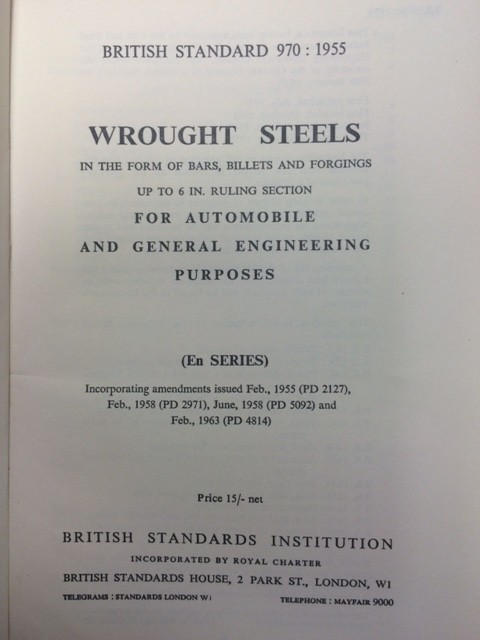 Add My Company
Add My Company

The History and Enduring Legacy of BS970 Steel Specifications
From EN1A to EN58 – and All the Grades In Between
When it comes to carbon and alloy steel specifications, few names resonate quite like BS970. Much like the Richter scale – no longer the official measure of earthquakes, yet still widely recognised – BS970 continues to be referenced across the steel industry, long after its official retirement.
But how many truly understand the remarkable history and impact of this legendary specification system?
Origins: The Birth of BS970
The roots of BS970 stretch back to the Second World War, a period that demanded unprecedented innovation and precision. The UK Ministry of Supply’s Technical Advisory Committee was charged with evaluating and standardising the steels necessary to meet the rigours of wartime manufacturing.
Led by Dr William A. Hatfield – a distinguished metallurgist and inventor of 18/8 austenitic stainless steel – the committee worked closely with the British Standards Institution (BSI). Their collaboration culminated in the creation of the War Emergency British Standard Specifications, known as the BS970 EN grades.
The initial system comprised 58 steel grades, spanning from EN1 (carbon steel) to EN58 (stainless steel). These standards played a critical role in ensuring consistency, performance, and reliability during one of the most demanding periods in modern history.
Post-War Developments: Refinement and Expansion
As peace returned and the UK entered a phase of rebuilding and industrial growth, so too did the BS970 system evolve. By the 1950s, a need for greater precision saw the original grades refined, introducing tighter controls over chemical compositions.
However, this early system lacked the flexibility required to keep pace with new developments. To address this, suffixes were introduced – such as EN36A, EN36B, and EN36C – allowing for specific variations of a base grade. Over time, this led to the creation of nearly 200 individual steel grades within the BS970 framework.
A New Era: The 1970s Alphanumeric Overhaul
By the 1970s, the ever-growing list of suffixes began to burden the clarity and usability of the system. A major overhaul was undertaken, transforming BS970 into a six-character alphanumeric system. This change not only improved clarity but also facilitated better alignment with emerging international practices.
For instance, the widely used EN8 grade became 080M40, offering clearer insights into composition and mechanical properties at a glance. This revamped format became a mainstay of the UK steel industry for decades to come.
The European Shift: BS970’s Gradual Decline
The 1980s marked a significant turning point. As European steel standards such as the Werkstoff Number and the Kurzname system gained prominence, the UK began a gradual transition toward harmonisation.
By 1991, the adoption of these European norms became official policy, and BS970 slowly receded into the background, its role increasingly ceremonial as international standards took centre stage.
The End of an Era: Official Withdrawal
In 2006, BS970 was officially withdrawn as a British Standard. But despite its formal retirement, the influence of BS970 is far from forgotten. Many steel mills still manufacture to BS970 grades, and countless engineers, machinists, and fabricators continue to use its classifications as a trusted reference point.
A Final Thought
In the world of steel specifications, BS970 is like the Richter scale. It may no longer be the official benchmark, but its clarity, consistency, and historic significance have left an indelible mark.
And while you can't measure steel strength with a seismograph (that’s a job for tensile testing machines – a story for another day), if BS970 were an earthquake, it would rank a solid 7.5 – a seismic force in the steel industry whose legacy continues to resonate 50 years on.
For more information on The Steel Standard That Was Killed Off But Refused To Die talk to West Yorkshire Steel Co Ltd

